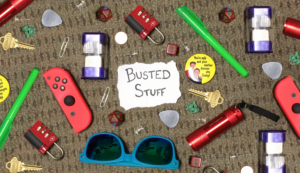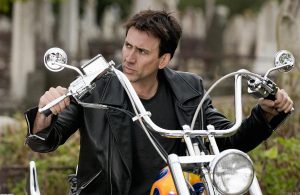A couple of weeks ago, a video began circulating on my Facebook news feed. It featured students in a high school all involuntarily defecating on themselves, with the caption stating that someone had spiked the school’s lunches with laxatives. My Facebook friends were sharing it saying, “This is insane,” or tagging their friends in the comments writing, “We should’ve done something like this in high school.” It seemed like everyone who shared it was either grossed out, amused, or a combination of the two.
I, however, immediately recognized that the video wasn’t from a real high school at all—it was from season 2 of American Vandal, a television show I consider to be one of the best of this decade.
American Vandal’s first season premiered on Netflix in 2017 and centered around a boy named Dylan Maxwell (Jimmy Tatro) who was accused of spray-painting penises on 27 of his teacher’s cars and was subsequently expelled. Two of his classmates, Peter (Tyler Alvarez) and Sam (Griffin Gluck), decided to make a documentary that attempted to figure out whether Dylan actually did draw the dicks.
The show presents itself as the documentary that Peter and Sam are filming, whilst actually satirizing the true-crime genre. In doing so, American Vandal proved itself to be a standout in the mockumentary sub-genre.
The concept of mockumentary has been around for decades. One of the first instances of it in the United States happened in 1938 on the radio, when actor and filmmaker Orson Welles read a fake news broadcast stating that Earth was being invaded by a Martian army. The effect of this was almost immediate, as the live broadcast hadn’t even ended before authorities came to CBS with reports of public mass hysteria—people believed it was real.
However, it wasn’t until much later that This is Spinal Tap (1984) revolutionized the mockumentary. The film satirized rock documentaries with a primarily improvised dialogue, establishing itself as one of the greatest comedies of all time, and, most importantly, providing a standard for mockumentaries to come. Recently, film has seen standout mockumentaries such as Popstar: Never Stop Never Stopping (2016) and What We Do in the Shadows (2014)—one of my favorite films of all time.
On television, shows like The Office and Modern Family have gained critical acclaim by following the standard mockumentary method: taking a topic (the modern office workplace or an everyday 21st century family, respectively) and satirizing it.
The Office, in particular, relies on the sub-genre for its comedy. When characters talk directly to, look at, or physically interact with the camera within the confines of their office, the humor lies in the fact that they’re communicating with the camera. The audience feels as if these characters are real because of the way they interact with the camera. The camera becomes as important as the actual characters and the situational absurdity is mediated by these interactions.
So it wasn’t a surprise to me that many people sharing clips from American Vandal on Facebook assumed that it was real. It harkens back to the radio instance in 1938, and that’s the whole point of the mockumentary—to satirize the genre it’s portraying whilst simultaneously becoming that genre. American Vandal perfects this.
Its premise is absurd. Who would care about a kid who got expelled for doing something as juvenile as spray-painting dicks enough to make a documentary? But where it excels is in its satire and realism. Jimmy Tatro gives an Emmy-worthy performance as the subject of the documentary, Dylan. He captures the essence of a high schooler whose troublemaker label he’s struggling to redefine.
Alvarez and Glick also do well as the documentarians, with Peter taking the project much more seriously than his co-producer and best friend Sam. If that wasn’t enough, the supporting characters all feel like real people, to which the documentary-style filming contributes greatly.
There is a scene in the first season in which Peter and Sam go through countless hours of social media footage from a party (that they weren’t invited to), in order to find evidence supporting the claim that Dylan planned the dick-drawing prank weeks in advance. The scene highlights how much the act of parody in mockumentaries relies on being a good version of the subject it’s parodying. The scene is suspenseful, as the viewers track the spray-can used to draw the dicks in the background of the party footage. You forget that the mystery you’re trying to solve is one about something so juvenile and instead become invested in the figuring out the truth.
The realism of the footage also points to another incredible aspect of American Vandal’s use of the mockumentary: making a statement. The scene is as thrilling as it is unsettling because of how true to life it is. The party feels like a real party, and the fact that Peter and Sam, and the viewers by proxy, are able to track everyone’s movement at that party through social media is a subtle reminder of how documented—how tracked—our lives are on a daily basis. Their use of mockumentary allows this point to hit home.
The series as a whole makes several points. At the end of the first season, the show delves into the ethical dilemmas that come with the true-crime genre. In it, Sara Pearson (Saxon Sharbino), confronts Peter about the inclusion of her hook-up list in the documentary. Why, she wonders, was it necessary to reveal her private text messages when it did not help solve the case and led to her being shamed by those who saw the documentary, including her own father?
This scene relies on its mockumentary aspect to highlight the fact that in true-crime series , the people being studied are real people, and the footage will have actual effects on their lives long after the camera stops rolling. Think Netflix’s true-crime series Making a Murderer. The debate surrounding the subject of that series was in public discourse for months after it was released. American Vandal takes this and uses it to look at just how easy it is to forget that the subjects of true-crime documentaries aren’t just characters—they’re people who actually exist.
The second season’s premise is perhaps even more ridiculous than the first. There is a person going by the name the “Turd Burglar” who is committing poop related crimes, including the aforementioned laxatives in the lunch. The season takes the show to new heights, exploring privilege and social media through the lens of true-crime.
This new season features crime scene reenactments, a classic true-crime trope. These reenactments have actors who look nothing like the people they’re portraying and are about crimes related to poop, hilariously poking fun at the often silly, amateur ones seen in true-crime.
There is a character in the second season named Demarcus Tiller (Melvin Gregg), who becomes a suspect. He is a low-income black teenager on a basketball scholarship at a rich, predominately white, Catholic high school. He is considered a basketball legend at the school and is practically worshipped, but scenes filmed at his neighborhood aren’t as joyous, funny, or bright—the show uses him to point out privilege.
Near the end of the season, in an episode that is thrilling, revealing, and brilliant all in one, Demarcus has a scene where he opens up to Peter about his vulnerabilities. At first glance, it’s a powerful scene in which a character whose nickname is literally “Mr. Untouchable” is revealed to have insecurities about social media and how the way he is exposed online allows people to use him. But then the viewer remembers that in the show this is a documentary, that Demarcus is sharing his vulnerabilities not to just Peter and Sam in a private moment, but to a camera that symbolizes a whole viewing audience once they share it. Peter and Sam, just like the people Demarcus worries about, have something to gain from this relationship with him, and with all of the subjects of their documentaries. Once again, the show is using its documentary format to highlight less talked about aspects of the true-crime genre.
Mockumentaries are unique in that they provide insights into the worlds they are mocking, whilst being a part of that world. The Office is making fun of office life, but it’s set in an office. American Vandal is critical of the true-crime genre, but it’s an incredibly compelling true-crime show in and of itself. American Vandal separates itself from the sitcom mold that mockumentaries tend to fall under on television, breathing new life into the sub-genre, and providing masterful television that is as funny and ridiculous as it is insightful and powerful.




